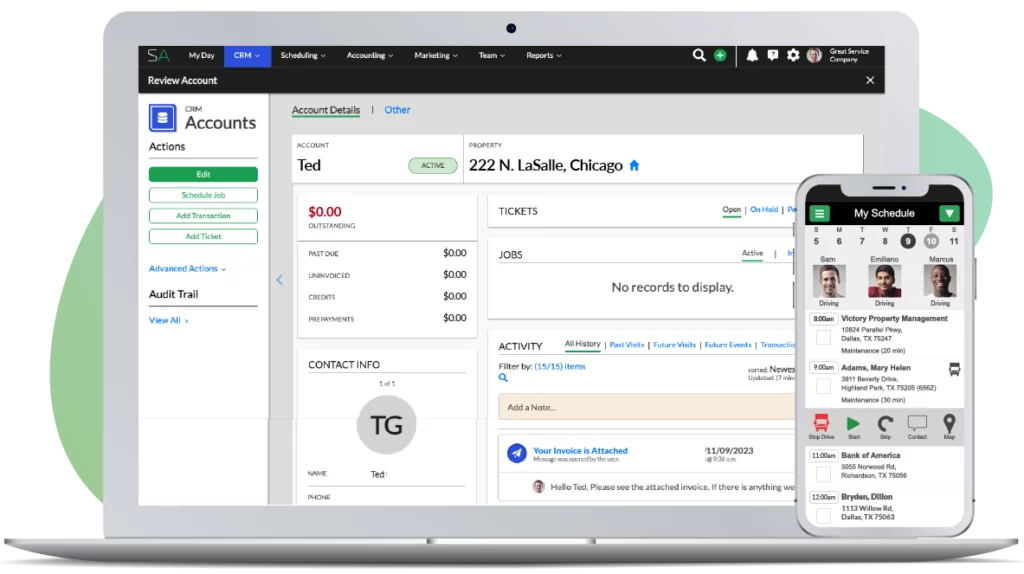Do you feel like you don’t make enough money in your lawn care & landscape business?
Are you frustrated? Not getting ahead?
Watch this video to learn exactly why this is happening and how to finally make money in your lawn care business.
In your lawn care business, do you feel like you don’t make enough money? Do you feel like as you grow your company, things aren’t getting better, that there’s never money leftover?
I’m going to show you in this video exactly why that’s happening. I’m going to show you why the business doesn’t feel like it’s ever improving.
Some of the common complaints that we hear from guys are, they feel like they’re not pricing the work correctly, not making enough money, the business never gets better, there’s never any money leftover no matter how hard they work or how much they grow, and they feel like they’re just always scraping by.
When they started the business, things felt good. Then, as the company grew, they felt like they could never get ahead…feeling trapped by the growth.
I’m going to show you some numbers. Now, if you get caught up in the numbers that I’m demonstrating, you’re going to completely miss my point because I have not put the thought into this to come up with real numbers. Don’t be caught up on the numbers, they’re only to get you thinking and to illustrate my point.
Let’s say when you first started out, you were working for somebody else working 40 hours a week.
You were making $14 an hour, which means you were taking home about $560 a week. We’re ignoring taxes and all that. Let’s say you were in this industry and the company had some seasonality in it, so you worked this job and maybe another. Again, just keeping this simple.
You worked 40 weeks of the year, so you were making $22,400 per year. Then you decide since you have all the experience, that you can start your own company and make a lot more money.
You go out and start a lawn care company. Let’s say, overnight you sell 40 hours a week worth of work. You are now doing the exact amount of work that you were doing for your prior employer. You’re working 40 hours a week, but now you’re selling your work at $30 a man hour.
Whether you’re mowing yards or doing irrigation or installation, you’re selling that time on average for $30 a man hour. If you’re mowing yards, and you price the yard at $30, that means it takes you about an hour.
If you’re making on average $30 a man hour, and you’re working 40 hours a week, you’re making $1,200 a week. You’re doing way better than you used to when you had your job. You’re still working 40 weeks, but you’re making $48,000 a year instead of $22,400.
Things feel good. You think, “This is great. If I could just grow this business more, I could make a whole lot more money. If I were to go get more jobs and hire more employees, think of all the money that I would make.” You think growth is going to fix your problem and it’s going to let you have this really great lifestyle and you’re going to make tons of money. You run the numbers and think, “Man, if I had people I’m going to make a lot more money.”
This is where you really can’t get stuck on my numbers.
If you’re selling time at $30 an hour, but now you get a helper. If two of you are doing a job together and you sell that job for $30, that means you can only be on that property for 30 minutes because your 30 minutes plus his 30 minutes equals one man hour. That’s $30.
If both of you work an hour on the job site, you better bill $60 to make $30 a man hour. Now you’re selling your helper’s time at $30 a man hour. You think, “Oh, I could hire a guy for $14 an hour. I could sell it for $30 an hour. Think of all the money I’ll make.” But there are all of these costs.
Let’s say when you think about how many hours a week you work and you take the cost of your truck, the cost of gas, the cost of equipment, and you just divide those costs out by the number of hours you work a week to arrive at an hourly cost to run the truck, hourly cost of gas, hourly cost of equipment.
I’m going to say it for the fourth time…these numbers are not exact and are solely to make a point.
When you run the numbers, you’ve figured out that it cost you about $2 an hour to run your truck (these are working hours), $1 an hour for gas, and so on.
This employee now has a truck, gas expenses, equipment expenses, supplies, he has insurance on his truck, materials cost, and you are paying his worker’s comp and a storage unit. There are so many other costs that I didn’t even account for here.
On an hourly basis, if you were to look at all those costs, he’s costing you about $21.67, which is quite a bit more than the $14 an hour. That doesn’t even account for payroll costs, or what they call labor burden. That’s immediately another 8% of the $14 an hour.
Now you’re billing him at $30 an hour but you’re spending $21.67 on him. For every hour you work this guy, you’re making $8.33. If you are still working 40 hours a week, and now your employee is also working 40 hours a week, you were making $30 a man hour before, now you’re making $38.33.
You were getting to take home, in my very elementary example, $30 a man hour which was equating to about $48,000 a year. What’s great is, now you’re also getting to take home another $8 a man hour because you have a helper. Well, then you get another helper. The realty is that you have to go sell enough time to keep this other guy busy. You now don’t have time to work 40 hours a week. You have to be doing things to generate business.
You’re out doing estimates, answering billing questions on the phone, answering sales questions, and selling. Now, you’re really putting in 70 hours a week.
You’re worn out. You’re working weekends and most nights. The business is starting to get really stressful and frustrating. The only answer is, you’ve got to work a little less. You need to get off the truck for part of the week so that you can do all the other activities of the business and have your team now generate the billable revenue.
As you add more employees, all of these new things happen in the business that take all of your time. You can’t be out there doing as much work. Let’s say that you were to get out of the field, or start to reduce your time in the field. If you want to continue to make $48,000, or make an equivalent of $30 an hour, you now have to take these guys so that you’re selling their time at $8.33. You now need 3.6 of these guys.
You need almost four guys out there in the field doing the work, so that with the money leftover, you can make the $48,000 a year that you were making before when you did all the work yourself.
Basically, now you have four guys doing the work for you, but now you’re busy doing all the other stuff for the business and you’re not making any more money. That tends to be the exact problem that most guys get into. You have four guys, you’re swamped, and you have no where to keep all your equipment.
Keep in mind, in my example there’s no profit leftover, you’re not building any money in your bank to protect you for a rainy day, and you’re not putting any money aside to go buy new equipment. You’re not doing any of the stuff that you need to be doing. Your are simply surviving in this example.
Now, you sit down one night and you’re overwhelmed and beat down because nothing is getting better. You have four employees but, they break stuff and things happen. That cuts into that $48,000 that you were making. You’re not always truly making $8.33 per guy. Something’s always happening.
You think to yourself, maybe if you had eight guys things would get better? That means you better get out there and hustle and sell and do everything it takes to grow the business.
Pretty soon you’re so busy again and you’ve hit a brick wall. You’re back in that same spot again. If you’re married, your wife’s worn out with you. If you’ve got kids, you never see them. You don’t know what to do.
You think, maybe you should get an office assistant. If you got an office assistant, that person could answer the phone and do a lot of the smaller activities that you’re doing so you’d be freed up to go do the bigger stuff.
You get an office assistant. Now you need an office and phones and you need all these other things. Your office equates to about $1 an hour for the time you sell across your guys. Your office assistant equates to about $2 an hour for every hour of time you sell for a guy.
You also have about $1 to help pay for the office expenses. The utilities cost you about 50 cents. Now, notice what’s happened down here, your cost has gone up to $25 a man hour, and so now you have to have almost five guys to make the same $48,000 a year you were making.
This is the trap that keeps happening. This is what happens so often.
A guy starts out and he’s making decent money. He wants to grow the company. You look up three years later and you’re thinking, “I’m not making any more money than I was making before. Maybe I’m making less or barely more, but I’ve got all these people, all these trucks, and I’ve got all this stuff going on. Why is there no additional money for me?”
It’s because you’re still selling time at the same price you were selling it when it was just you. But now, you have all of these expenses you never had before. I didn’t even put in marketing expenses. There is a whole list of expenses that I didn’t account for. This, again, is a super elementary example. My numbers are all wrong, but you get the idea. This is exactly what happens.
Now look what happens if overnight you were to change your hourly rate to $40 a man hour. Now how many guys do you need? See? You’re now making almost $12 an hour for every hour you sell of a guy’s time. Now you only need about three guys.
Let me just illustrate that one more time because this is a critical point. I need almost 17 guys when I was selling time at $30 an hour. If I sell my time at $40 an hour, I need barely two guys to make what I was making before. Now imagine that I actually still had the 17 guys, but now I’m making $11.83 per man hour on my 17 guys. Let’s do that math.
For every hour that ticks by in the day that you have 17 guys out in the field making you money, making you $11.83 an hour, you’re accumulating $201 every hour that passes. On a 40 hour week, you’re accumulating $8,000 a week. Originally you were making $48,000 a year, and we used the example of working 40 weeks a year. Now, you’re making $321,000 a year.
Now, this is an exaggeration. With 17 workers, you’re not going to make $321,000 a year in take-home pay and be growing the business and everything else that it takes. My numbers are flawed, but can you see the difference in the problem?
Originally you kept your hourly rate at the same hourly rate as you were originally selling time for when it was just you and you felt good. You were making money. Then as you grew the business and you acquired all of these additional expenses, you didn’t consistently adjust your rate. As a result, you kept adding people, but the business wasn’t getting better. In my example, we were still selling time at $30 a man hour.
It was taking something like 17 guys to generate the same income that you were making years back. By simply adjusting our rate that we sell time for, look at the dramatic difference it had. You would go from making $48,000 a year to $321,000 a year. This is the power of constantly adjusting your rates.
Now, granted, you can only sell time for so much. You have to be competitive in your market. The trap is that so many guys go out and they build a company and everything’s going well. They keep adding more and more expenses to their business, but the rates aren’t going up. They’re either not becoming more efficient as a company, or they’re not adjusting the rate that they sell time for. Their margins keep getting smaller and smaller.
The only way to solve the problem is to keep hiring more and more people and selling more and more. You can’t sell your way out of this problem. You have to, at some point, correct your pricing. For those in commercial contracts, or those in residential contracts, the only way to fix the problem is to either get rid of all the work that originally built your company, or raise the pricing on all the work that originally built your company.
Oftentimes, the contract that you have doesn’t respond well to you taking as big a price increase as you need. If you realize three years later that you’ve been underpricing and you have to go back and raise prices 30%, that immediately gets most of your clients to go out and look for better pricing because it’s such a huge price increase.
Oftentimes, that’s the only way a guy can fix his business because he was underpricing his work from day one. This is maybe my final point. If you’re watching this and you’re just getting started in business, make sure that you’re pricing your work today, right now, at a price that will support your business as if you already have all of this additional cost.
Now, with that being said, if you’re pricing your work correctly today, when it’s just you and maybe a couple of helpers, then you should be making a lot of money. Don’t spend all that money. You should be putting it in the bank to help fund the growth of the company.
Let’s say, you’re out there with a couple of workers and you’re making $65,000. If you’re spending all that $65,000 to support your personal lifestyle, when you want to grow the company and you go through the phases of your business where you start to hire people and start to add costs, you won’t have the money to put in. You go through these ups and downs in the business where some of that money that you’re pocketing now is needed for the business. You can’t take quite as much out because you’ve got to invest a bit in the business to hire some people and buy some equipment.
My point there is that this is what happens. This is a common trap. A lot of guys early on make a lot of money when they’re pricing correctly. If they spend all that money to buy a house, a car, a cool truck, or whatever, if they’ve got kids, now they have no money leftover. They have to continue to make that 65 to 70 grand a year just to live personally.
These guys have no money to invest in the business. They aren’t able to take a temporary pay cut to afford all the expenses of the business to take it to the next level.
If you pay attention to these numbers from day one and you’re aware of them, you will grow so much faster and your business will be so much better.




One Reply to “Why You Never Make Money in Your Lawn & Landscape Business”
Your article points to the exact reason that a beginner should never price their work any different than bigger, more established service providers. Low sales prices never allow you to grow and prosper. The wrong type of client is attracted to low prices. When prices are raised to the number it really takes to be in business, cheap clients flee, and then you are stuck with trying to find a new type of client to pay your rate. It’s a new learning curve as to what the new clients expect.
The best idea, do some serious home work and get it right the first time. Even if you have no clue as to what you are doing, copy a truly successful person and then learn what they do an why it works.